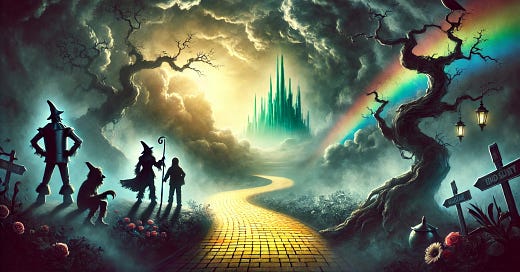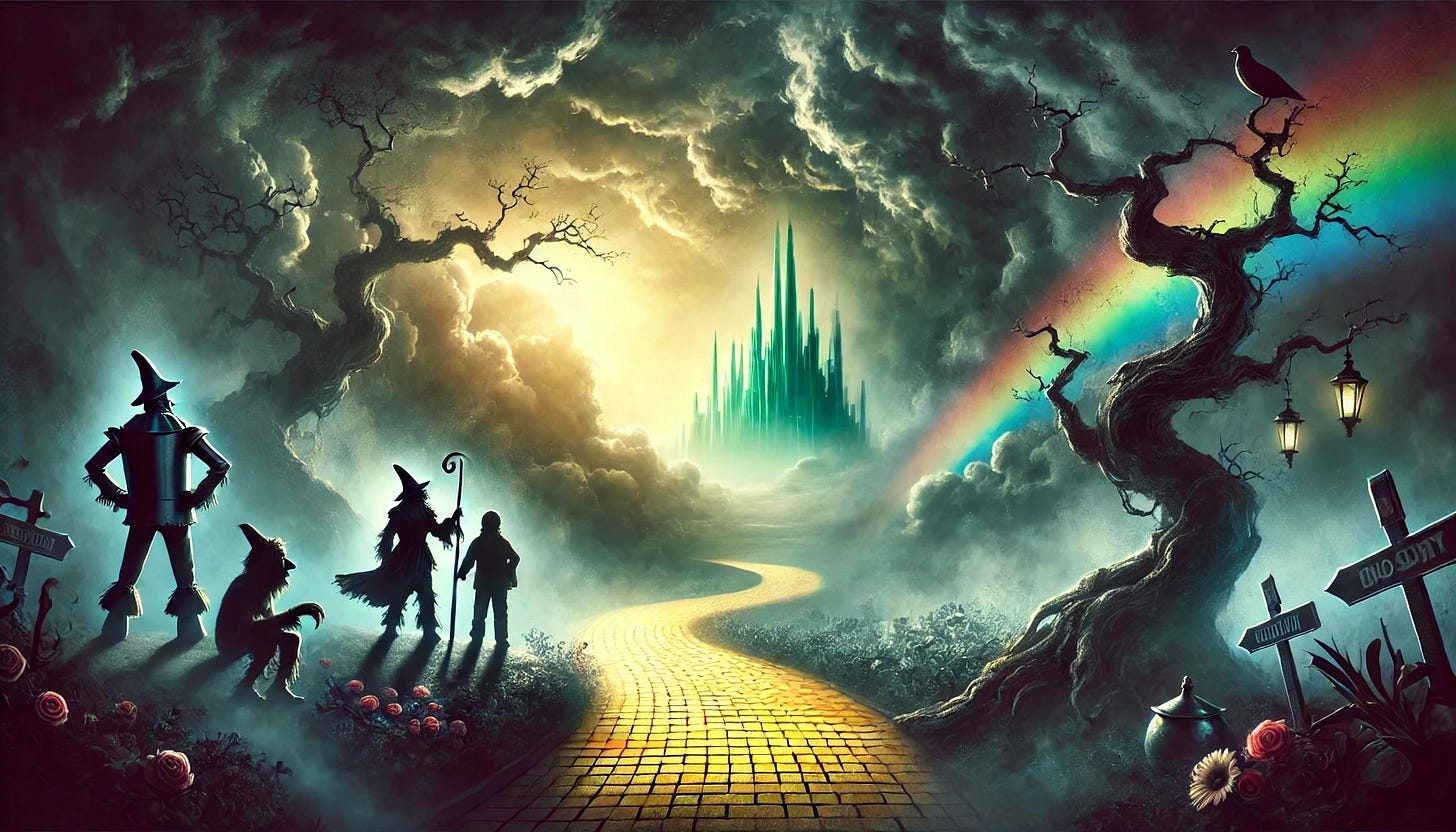The Wizard of OZ
Where you worry the most, is where you trust the least.
The Illusion
According to the U.S. Library of Congress, The Wizard of Oz is the most-watched film in movie history.
It tells a timeless story of self-discovery and the pursuit of personal fulfillment.
Dorothy, a young girl from Kansas, is swept away to the magical land of Oz by a fierce tornado. Upon waking, she is greeted by Glinda, the Good Witch of the North. Soon after, the Wicked Witch of the West appears, attempting to steal the magical ruby slippers. Before she can do so, Glinda magically places the slippers on Dorothy’s feet as protection. Desperate to return home from the storm, Dorothy is encouraged by Glinda to follow the Yellow Brick Road to the Emerald City, where she believes the Wizard of Oz can help her.
Along the way, she meets the Scarecrow, who longs for a brain, the Tin Man, who desires a heart, and the Cowardly Lion, who seeks courage. Together, they face numerous challenges, including being captured by the flying monkeys—sent by the Wicked Witch of the West to deter them from their journey. They persevere, eventually reaching the Emerald City, where they hope to have their inner voids filled by the Wizard.
However, their hopes are dashed when Toto, Dorothy’s loyal dog, pulls back the curtain, revealing the Wizard to be a mere man, not the powerful figure they believed. The man behind the curtain was controlling others through deception, disguising himself as someone good and powerful, but ultimately only deceiving himself.
When the veil is lifted, truth stands bare, unmasked by illusion, and what was once hidden is seen with clarity.
The Truth
Nothing is ever as it seems.
Lyman Frank Baum, the author of The Wizard of Oz, cleverly exposed deeper truths by designing characters that represented the social and political climate of America at the time. Interestingly, much of what he highlighted remains relevant in modern society. Through these characters, Baum emphasized the power of inner strength, friendship, and the realization that what we often seek externally is already within us.
Character Representations:
Dorothy: Represents the average person and the goodness of humanity.
Scarecrow: Symbolizes American farmers and their struggles.
Tin Man: Represents industrial workers and the failures of the American steel industry.
Cowardly Lion: A symbol of politics, particularly William Jennings Bryan, the leader of the Populist Party and a presidential candidate in 1896.
Wicked Witch of the West: Represents the American West and the Gold Rush.
Winged Monkeys: May represent Native Americans, viewed as a perceived danger in the West.
Yellow Brick Road: Symbolizes the currency debates in the U.S. about whether the dollar should be backed by gold or silver. Interestingly, Dorothy’s ruby slippers were originally intended to be silver, not red.
Emerald City: Represents Washington, D.C., the U.S. capital, where everything appears a magical green due to the influence of dollar-colored glasses.
Tornado: A metaphor for political revolution, symbolizing the potential transformation of the country into a land of prosperity.
Poppy Field: An allegory for the pharmaceutical industry and its influence on society.
Who Are You?
"For where your treasure is, there your heart will be also." — Matthew 6:21 (NIV)
Throughout my years of consulting and connecting with thousands of people on their own personal "Yellow Brick Road" to achieving personal, professional, and financial goals, one of the first questions I ask them is: Who are you?
Their answer usually gives me immediate insight into where their mind is focused (brain), what they truly desire (heart), and how confident they are in their abilities (courage).
Interestingly, I often have to ask the question multiple times to get to the real answer. Most people’s initial responses revolve around what they do, not who they are. Try it for yourself—ask someone nearby: Who are you?
The simplest questions are often the hardest to answer—much like the solutions to your own problems in the Land of OZ. For me, and many of my clients, it’s the journey itself, and the act of helping others along the way, that shifts our perspective. Often, we realize our problems are not as daunting as they seemed.
As we navigate life’s challenges and pursue success, it’s easy to lose sight of our true identity. We get caught up in chasing external goals, often illusions set by society, forgetting who we are at our core and what we truly value.
So, at the end of your own yellow brick road—after the illusions fade and the obstacles are behind you—who are you, really? If you don’t define that for yourself, someone else will try to do it for you.
Ironically, it’s the storms in life that have to hit our house for us to learn how to build and truly appreciate it as a home—because at the end of the rainbow, you’ll find your true treasures, and there’s no place like home.
- Stay Blessed
Tyler Bossetti




